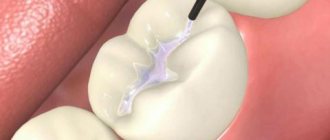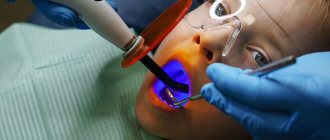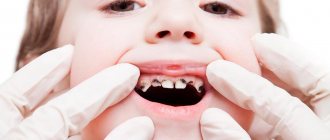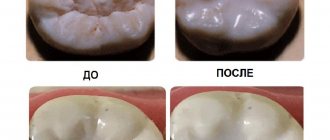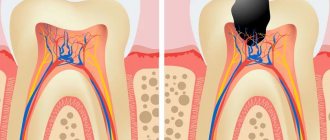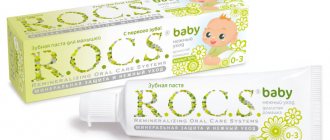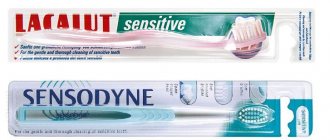What are dental fissures
There are fissures on both baby teeth and permanent teeth.
These are physiological folds - grooves, dimples and depressions - on the chewing surface of molars and premolars. The incisors and canines do not have fissures. Such cavities easily and quickly fill with plaque, are poorly cleaned with toothpaste and a brush - they become a common cause of carious lesions. Pediatric dentists often suggest sealing fissures - creating a thin film on the surface of the crown that will protect against pathogenic microflora and mechanical damage.
There are two main reasons for fissure sealing:
- Children's inability to take good care of their teeth. Even the most responsible child is not able to clean all the cavities on the surface of molars and premolars, which leads to the development of caries and the need for treatment. Especially if the grooves differ in depth and tortuosity.
- Thin enamel of teeth - milk and permanent during the period of change of bite. The thickness of the enamel of temporary units is half that of permanent ones, which explains its rapid destruction and susceptibility to caries. During eruption, molars are especially vulnerable - initially the crowns are covered with thin, slightly mineralized enamel, and only after 2-3 years the surface becomes resistant to external damage.
Rodikova Tatyana
Before recommending invasive fissure sealing to a patient, I always look at the initial level of mineralization. With a high mineral content and wide grooves, sealing cavities can be easily done without sealing, but there are cases (low mineralization, prone to caries) when sealing the teeth is the best option!
Indications for use
Many citizens are sure that the most important microelement for teeth is calcium. This is partly true: calcium is responsible for the structural strength of bones. However, fluorine is important for enamel; it is what ensures the strength of its structure. Fluoride is absorbed not only with water and food; this microelement is well absorbed by the enamel from the outside. Therefore, scientists created the drug Fluorlak. Let's consider the question: Fluoride varnish instructions for use.
Enamel protection with a fluoride-containing agent is carried out in dental clinics. However, you can coat your teeth with fluoride varnish yourself. A home procedure will be much cheaper and will save time. Who is the fluoridation procedure indicated for? A lack of fluoride in drinking water provokes massive caries disease, so fluoridation is primarily indicated for people living in the area. The use of the drug is also indicated:
- people with high enamel permeability;
- pregnant and elderly people;
- children over six years of age living in areas with low fluoride content in water;
- with mechanical destruction of enamel: chips, cracks;
- before placing dentures (after grinding the crown);
- after ultrasonic cleansing;
- with a wedge-shaped defect.
A contraindication to fluoridation is an excess of fluoride in bone tissue (fluorosis) and sensitivity to the components of the drug.
Fluoridation in the doctor's office
How does the fluoride varnish treatment process work? The dentist uses a special brush or roller for this. Before the procedure begins, the crowns of the teeth are treated: plaque is removed, and any hard formations are removed. Then salivation is eliminated and the surface of the teeth is dried.
The coating begins with the lower jaw, after which it moves to the upper dentition. When the treatment is completed, the patient remains with his mouth open for some time until the composition dries completely. After fluoridation, you should not brush your teeth or eat hard foods for a day, so as not to damage the fresh layer of varnish. Since it is impossible to apply a thick layer of fluoride in one procedure, fluoridation is carried out several times at intervals of 3-4 days.
How long will fluoride varnish last in dentistry? Typically, the protective film lasts for six months, so after this period of time the procedure should be repeated. Does this product change the color of the enamel? No, a similar effect was not noticed after using Fluoride Lac.
Fluoride varnish for teeth at home
How to apply fluoride varnish for teeth at home? Coating teeth with the composition is not difficult, however, buying the drug is quite problematic: it cannot be found in pharmacies. To purchase this product (Fluorolak Omega), you must place an order in stores specializing in the sale of dental products.
How to apply fluoride varnish instructions:
- Clean your mouth with paste.
- Dry the surface of the teeth: to do this, wipe the crowns with a cotton swab or place gauze pads between the lips/cheek and isolate the teeth from saliva.
- Soak a cotton swab in the solution and rub the enamel (it is better to start treating the crowns of the bottom row).
- Keep your mouth open until the mixture dries (takes about five minutes).
Important! After treating enamel with fluorine-containing varnish, you should not eat for 12 hours, so it is advisable to carry out the procedure in the evening. The sooner the food touches the coating, the less time it will last.
What difficulties may arise during the home fluoridation procedure? Do not allow the composition to come into contact with the mucous membrane. It is necessary to carefully monitor the application of fluoride varnish to the teeth. If the product gets on the mucous membrane, it can cause negative consequences - a burn.
Treatment of baby teeth against caries: indications
Typically, fissure sealing is carried out at the request of the parents. But sometimes dentists recommend the procedure, since sealing fissures reduces the risk of developing caries in milk and permanent teeth. The indications are:
- Young age of the patient. The enamel of newly erupted teeth has a thin layer. It is not sufficiently saturated with fluorine and calcium and is susceptible to destruction.
- Pathologically thin enamel. Sometimes the structure of tooth enamel does not change over time - it remains thin and susceptible to microorganisms.
- Curvy and narrow grooves on the teeth. The complex shape makes daily high-quality teeth cleaning impossible.
- Malocclusion and abnormal position of molars and premolars.
- Insufficient oral hygiene.
- Primary signs of enamel demineralization are stains on the tooth surface and superficial caries.
Among the contraindications:
- Carious lesions - sealing is allowed after dental treatment.
- Wide and open fissures - accessible for everyday high-quality cleaning with toothpaste.
- Allergy to sealant coating - instead of sealing, enamel silvering, remineralization, and fluoridation are available.
- Heavy salivation.
- Long-term eruption of a baby or permanent tooth – more than 4 years ago.
Silvering of teeth: advantages and disadvantages of the procedure
Coating children's teeth with silver is one of the most gentle technologies for treating childhood caries in the initial stages. This method is not new in dentistry; it has been used for many decades. The noble metal itself is not used in treatment, but only its active salts. The tooth surface treated in this way becomes denser and more resistant to food acids.
Silvering of teeth is effective only in the initial stage of the carious process, when it appears on the enamel as small spots. The technique is indicated for children under three years of age.
The positive aspects of the procedure include:
- an excellent way to stop the progression of caries on a child’s teeth;
- silvering does not cause negative reactions on the part of a young patient;
- The cost of the procedure is low, which makes it accessible to all patients.
The disadvantages of coating children's teeth with silver include:
- the formation of black plaque on the tooth surface, which does not create an aesthetic effect;
- For deep carious lesions, the technique cannot be used.
Dentists do not recommend silvering the front teeth, because the resulting black plaque causes psychological discomfort in the child. Along with this, there are other contraindications: allergies to the components of the drug, the patient has somatic diseases, in cases of dentin damage by caries and the child is over 3 years old.
Among the most popular drugs for the silvering procedure are domestically produced Argenate and Japanese Saforide. Both products have a therapeutic and prophylactic effect on tooth enamel and are completely harmless to the child’s health.
Seal your child’s teeth from caries: how fissure sealing is carried out
Fissure sealing is a painless and short procedure. To carry it out, a “sealant” material, a fissure sealant, is used. Sealant is a high-strength composite composition that hardens under the influence of light. Its feature is increased fluidity, thanks to which the sealant is able to fill even hard-to-reach places on the tooth crown. Also among the advantages of the sealant:
- Waterproof – resistant to saliva.
- Durability – the coating lasts on the teeth for up to 5 years.
- Aesthetics - sealants are produced in transparent, beige, and colored.
Stages of fissure sealing of primary and permanent teeth:
- Removing plaque from enamel and all cavities. Polishing the crown surface.
- Treatment with an antiseptic composition.
- Drying teeth and protecting the treated unit from the influence of saliva.
- Application of acid gel to enhance adhesion and create a slightly rough surface.
- Rinse off the composition and dry the tooth.
- Filling fissures with liquid sealant - applying sealant.
- Creating conditions for hardening - chemical activation or using a light lamp.
- Removing excess material.
- Coating the tooth with a fluoride-containing strengthening gel.
The optimal age of a child for fissure sealing is 6-8 years. During this period, the first permanent molars erupt and need protection. The procedure is indicated for children aged 1.5-2 years, and adolescents aged 12-14 years. The appearance of any wide tooth is a reason to carry out dental sealing and reliably protect the enamel from destruction for several years.
Plaksina Margarita
I am often asked what they cover children's teeth with to protect them from caries. At Aza&Buka we use sealants - special gels. They not only seal the surface of the tooth, but also strengthen the enamel by releasing fluoride ions.
Carrying out
Coating teeth with fluoride varnish includes the following steps.
- Hygienic cleaning of enamel from plaque and stone.
- Isolation of teeth from the oral cavity.
- Drying with cotton swabs.
- Coating the enamel with a product using a brush or applicator.
- Fixing the film for 5 minutes.
The dentist determines the number of layers individually. The strength of the film increases within 12 hours. During this time, you should not brush your teeth or eat solid foods. To enhance the effect, 3 sessions may be required. How often do experts recommend fluoridation of enamel? Twice a year is enough if there are no individual indications.
Methods for filling children's teeth against caries
There are different ways to seal baby and permanent teeth. In the capital's dentistry they offer:
- Non-invasive sealing - the procedure is carried out without compromising the integrity and structure of the tooth. The method is suitable for healthy teeth with a wide distance between the cusps on the crown. The doctor sequentially applies the compounds, closing and protecting the cavities.
- Invasive sealing - the doctor processes the enamel for better access to hidden areas on the surface of the molar in the presence of narrow and deep fissures. The procedure is also indicated if it is necessary to treat caries.
Dolotova Marina
Experience shows that sealing fissures reduces the risk of developing caries several times. This can be seen if we observe patients with a similar enamel structure and attitude towards dentistry. Children with sealed fissures keep their teeth intact and healthy for a long time.
Surface fluoridation of teeth
Surface fluoridation of teeth is a set of simple and painless dental procedures that involve enriching dental tissues with fluoride using special gels or varnishes.
In the first case, an individual dental tray filled with sodium fluoride or another fluoride-containing drug is used for remineralization. The device is carefully placed on the patient’s teeth and held on them for about a quarter of an hour. To achieve the desired effect, the procedure is carried out 3 times in a row with an interval of 2 days.
Stages of surface fluoridation
In turn, fluoridation of teeth using fluoride varnish is carried out in several stages and involves:
- cleaning the enamel layer from deposits;
- drying the surface layer of teeth with warm air;
- applying fluoride-containing varnish to the enamel using a special brush or a ball of sterile cotton wool (the upper row of teeth is initially treated, and then the lower row);
- drying the varnish.
After completing the procedure, the patient is advised to stop eating solid foods and brushing his teeth for a day. To achieve a lasting result, the varnish is applied to the enamel surface several times with an interval of 2 days. A second course of fluoridation may be required no earlier than after 7 months.
How to protect baby teeth from caries
Fissure sealing is an effective method of caries prevention. But you can't rely on the dental procedure alone. To maintain and preserve the health of children's teeth it is also necessary:
- Proper nutrition - more solid vegetables and fruits, fermented milk and dairy products, minimizing sweets.
- Systematic dental care - you need to brush your teeth twice a day, and when correcting your bite with braces, after every meal.
- Scheduled visits to the doctor - dentists invite you for an appointment every six months, and sometimes more often.
- Selection of toothpaste and toothbrushes according to age - when purchasing care products, you should focus on the dentist’s recommendations.
Pediatric dentistry today offers non-invasive and invasive techniques for fissure sealing. When choosing a doctor, you should focus on the dentist’s experience, reviews and recommendations. To increase the effectiveness of the procedure, make an appointment immediately after the chewing surface has erupted - when the crown becomes visible and accessible for treatment.
Deep fluoridation
The technique of deep fluoridation of enamel is a complex of dental procedures, which are based on the professional treatment of teeth enamel - sealing liquids.
Stages of deep fluoridation
This procedure consists of the following steps:
- sanitation of the oral cavity, professional dental cleaning;
- drying the surface of the teeth with a directed flow of warm air;
- applying magnesium fluoride silicate with calcium and copper ions to the enamel;
- repeated drying of the tooth surface with warm air;
- application of highly dispersed calcium hydroxide to the enamel.
Proper implementation of the procedure allows for deep penetration of the enamel-sealing liquid into the affected tissues and creates a maximum concentration of fluoride ions in them. In this case, the natural mineral structure of the teeth does not undergo any changes.
What does Dr. Komarovsky say about dental fluoridation in children?
Regarding fluoridation of teeth in children, Komarovsky claims that this procedure is not therapeutic, but for preventive purposes it gives a positive result, preventing damage to the enamel surface from mechanical stress and caries. This technique ensures the integrity of the dental teeth and, after replacing them, the permanent incisors remain healthy for a long time.
It is not recommended to use the application if children have an advanced stage of caries. In this case, it is necessary to either carry out treatment or remove the diseased incisor. The doctor believes that if parents monitor the condition of their children’s oral cavity from an early age and use toothpastes containing fluoride, their children’s teeth will be healthy and snow-white without additional procedures.
Therefore, this method is a forced preventive measure, which is prescribed not for the aesthetic beauty of the oral cavity, but to prevent the development of caries and destruction of the enamel surface.
In order for the baby to have healthy teeth, parents need to select toothpastes that contain fluoride, teach the child to use a mouthwash, and also visit the dentist regularly to prevent oral diseases
Category Children Published by Mister stomatolog
Benefits of deep fluoridation
The main advantages of deep fluoridation are:
- reduction in the incidence of caries by 65%;
- improving the structure of the enamel layer;
- significant reduction in tooth sensitivity;
- tenfold increase in the density of tooth enamel;
- reducing the risk of developing secondary caries;
- increasing the service life of previously placed fillings;
- quickly normalize the condition of the oral mucosa and gum tissue.
It has been proven that the effect of deep fluoridation lasts for 11 months after the end of the preventive course. However, this does not mean that this procedure provides complete protection of teeth from caries and other dental pathologies. Both deep and superficial fluoridation can only reduce the risk of developing diseases and increase the resistance of enamel to the action of destructive environmental factors. In order to ensure comprehensive dental protection, sufficient attention should be paid to all existing preventive measures.

